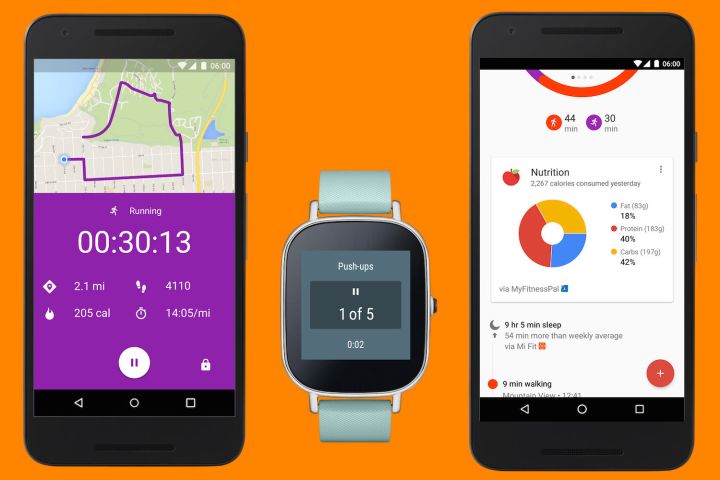
Luckily, tools like Google’s activity-recording Fit app make both of those tasks easier, and today, the aforementioned service is getting interface and usability improvements that should make adhering to a balance of diet and exercise a snap.
The newest Google Fit app, version 5.7, introduces new colors, charts, and highly visible stats. There is a playful new graphic on the home page — an abstract sketch of a jogger against a purple background. And the thick, circular bar in the outmoded app, which indicated how far in minutes, calories, steps, and miles you were from your daily activity goals, has been replaced by a slimmer, smaller indicator in the same purple color as the app’s new background, offering miniature, historical progress indicators from the past days of the week beneath it.
Finally, the day’s fitness metrics are now collated in a single line near the app’s welcome screen — an improvement over the old app’s behavior, which hid them behind a few swipes to the left and right of the progress bar.

The home page isn’t the only thing that has gotten a fresh coat of paint. Google Fit’s new “goal” interface lets you configure multiple, specific fitness objectives at once, and set a duration for each. Want a reminder to complete ten push-ups this evening, a pilate set at the end of the week, and a 3-mile jog every couple of days? Fit’s now happy to oblige. You can define goals by duration, calorie expenditure, or another metric of your choosing, and schedule them to recur as often and for as long as you’d like. Active fitness objectives — and their associated progress indicators — appear on the home screen.
The new Google Fit packs enhancements in other, minor areas. It has a new Android Wear watch face, Google Fit Today, that shows your daily fitness stats, and an improved Wear app, that shows a summary of fitness stats and a shortcut to workout routines like walking, biking, running, and sit-ups. And there’s an improved home-screen widget for your phone that shows your daily progress.
The new app is available on the Google Play Store. It rolls out to existing Fit users today.
The update is the first Google Fit has seen since November, when Google rolled out real-time stats, integration with third-party nutrition apps such as MyFitnessPal and LoseIt, sleep-tracking fitness bands like the Xiaomi Band, and automatic activity detection and fitness challenges. At the company’s developer conference in June, it announced that Android Wear 2.0, the forthcoming update for its smartwatch operating system, would sport Google Fit’s automatic activity recognition “built in.”
Editors' Recommendations
- A new Google Pixel Tablet is coming, but it’s not what you think
- Google is launching a powerful new AI app for your Android phone
- What is Google Assistant? Here’s the guide you need to get started
- Latest Street View app update will send you back in time
- Google Wallet is back and it has some new tricks

